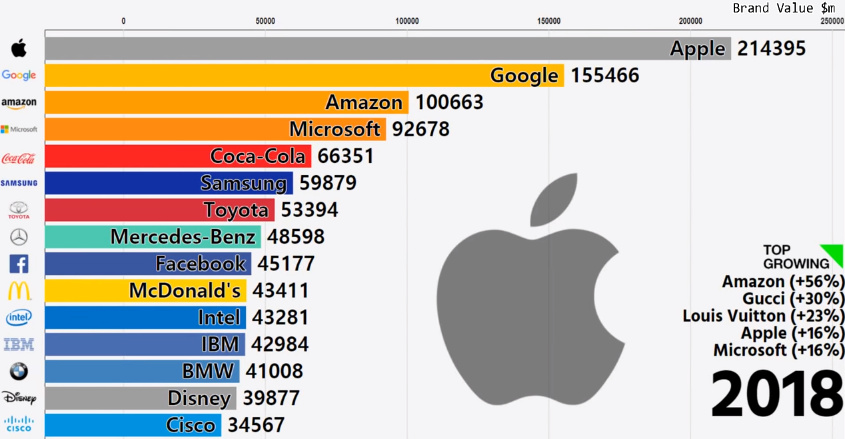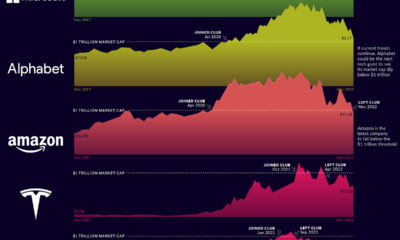Tobacco company Marlboro is still one of the top 15 global brands with a value of $22 billion, while companies like Nokia and AT&T also help to round out the group. Aside from Microsoft, the tech companies at the time were mostly focused on hardware and services. HP was considered a top global brand at the time, and even IBM was still making PCs until the year 2005.
The Platform Revolution
How times have changed. In today’s animation from TheRankings, you can see how the list of the top 15 global brands has evolved over the last two decades or so. The visible shift: as soon as Google hits the rankings in 2008 (2:21 in video), it becomes clear that the money is on the software side – particularly in coding software that ends up as a dominant consumer platform.
The Problem with Hardware
What’s the difference between the big hardware firms of old, and the successful ones that dot the list today? From a business perspective, hardware companies need to have a bold and accurate vision of the future, constantly taking innovative strides to beat competitors to that vision. If they can only make incremental improvements, the reality is that their competitors can enter the fold to create cheaper, similar hardware. Samsung, which finished 2018 as the world’s sixth most valued brand, is a good example of this in practice. The company has had the top-selling smartphone for every year between 2012-2018 – an impressive feat in staying on top of consumer trends and technology.
Why are Platforms so Dominant?
Constant innovation is a good barrier to entry if you can keep doing it – but the platforms have an even more bulletproof strategy: being everywhere at once. Facebook uses the powerful network effect from billions of people as a moat, and then it buys up-and-comers (Instagram, WhatsApp) to cover even more ground. As a result, competing with Facebook is a nightmare – even if you could theoretically acquire new users at $1 per user at a ridiculous scale, it would require a marketing investment of billions of dollars to make inroads on the company’s audience. Microsoft owns various platforms (Windows, Xbox, LinkedIn, Azure, etc.) that help insulate from competition, while Google’s strategy is to be everywhere you need to search, even if it’s in your living room. Because platforms have massive scale and are ubiquitous with consumers, it gives them the ultimate pricing power. In turn, at least so far, they have been able to establish the world’s most powerful consumer brands. on But fast forward to the end of last week, and SVB was shuttered by regulators after a panic-induced bank run. So, how exactly did this happen? We dig in below.
Road to a Bank Run
SVB and its customers generally thrived during the low interest rate era, but as rates rose, SVB found itself more exposed to risk than a typical bank. Even so, at the end of 2022, the bank’s balance sheet showed no cause for alarm.
As well, the bank was viewed positively in a number of places. Most Wall Street analyst ratings were overwhelmingly positive on the bank’s stock, and Forbes had just added the bank to its Financial All-Stars list. Outward signs of trouble emerged on Wednesday, March 8th, when SVB surprised investors with news that the bank needed to raise more than $2 billion to shore up its balance sheet. The reaction from prominent venture capitalists was not positive, with Coatue Management, Union Square Ventures, and Peter Thiel’s Founders Fund moving to limit exposure to the 40-year-old bank. The influence of these firms is believed to have added fuel to the fire, and a bank run ensued. Also influencing decision making was the fact that SVB had the highest percentage of uninsured domestic deposits of all big banks. These totaled nearly $152 billion, or about 97% of all deposits. By the end of the day, customers had tried to withdraw $42 billion in deposits.
What Triggered the SVB Collapse?
While the collapse of SVB took place over the course of 44 hours, its roots trace back to the early pandemic years. In 2021, U.S. venture capital-backed companies raised a record $330 billion—double the amount seen in 2020. At the time, interest rates were at rock-bottom levels to help buoy the economy. Matt Levine sums up the situation well: “When interest rates are low everywhere, a dollar in 20 years is about as good as a dollar today, so a startup whose business model is “we will lose money for a decade building artificial intelligence, and then rake in lots of money in the far future” sounds pretty good. When interest rates are higher, a dollar today is better than a dollar tomorrow, so investors want cash flows. When interest rates were low for a long time, and suddenly become high, all the money that was rushing to your customers is suddenly cut off.” Source: Pitchbook Why is this important? During this time, SVB received billions of dollars from these venture-backed clients. In one year alone, their deposits increased 100%. They took these funds and invested them in longer-term bonds. As a result, this created a dangerous trap as the company expected rates would remain low. During this time, SVB invested in bonds at the top of the market. As interest rates rose higher and bond prices declined, SVB started taking major losses on their long-term bond holdings.
Losses Fueling a Liquidity Crunch
When SVB reported its fourth quarter results in early 2023, Moody’s Investor Service, a credit rating agency took notice. In early March, it said that SVB was at high risk for a downgrade due to its significant unrealized losses. In response, SVB looked to sell $2 billion of its investments at a loss to help boost liquidity for its struggling balance sheet. Soon, more hedge funds and venture investors realized SVB could be on thin ice. Depositors withdrew funds in droves, spurring a liquidity squeeze and prompting California regulators and the FDIC to step in and shut down the bank.
What Happens Now?
While much of SVB’s activity was focused on the tech sector, the bank’s shocking collapse has rattled a financial sector that is already on edge.
The four biggest U.S. banks lost a combined $52 billion the day before the SVB collapse. On Friday, other banking stocks saw double-digit drops, including Signature Bank (-23%), First Republic (-15%), and Silvergate Capital (-11%).
Source: Morningstar Direct. *Represents March 9 data, trading halted on March 10.
When the dust settles, it’s hard to predict the ripple effects that will emerge from this dramatic event. For investors, the Secretary of the Treasury Janet Yellen announced confidence in the banking system remaining resilient, noting that regulators have the proper tools in response to the issue.
But others have seen trouble brewing as far back as 2020 (or earlier) when commercial banking assets were skyrocketing and banks were buying bonds when rates were low.














